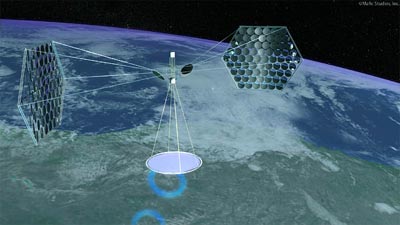The chicken and the egg: RLVs and space-based solar powerby Taylor Dinerman
|
| We are back to the old question: is the technology ready or nearly ready to allow for the development of a successful reusable launch vehicle (RLV)? For the last three or four years the answer from NASA and from the US military has been “No”. |
They are waiting for a breakthrough similar to the one that shifted most aircraft propulsion from piston engines to jet turbine ones. For those experts who want to gain a good understand of where things stand, Appendix D of the SBSP study provides an interesting look at where the NSSO’s experts think the Technology Readiness Levels (TRL) now stand. In order to have routine access to low Earth orbit (LEO) to achieve this goal the study examines a three-phased approach.
Phase one proposes a strategy that will “Develop new, fully-reusable two-stage, rocket-powered space access systems (aerospaceplanes) for passengers and cargo transport.” The mission is to “Transport passengers and cargo with ‘aircraft-like’ safety and operability.” The report claims that for such systems the TRL is 6–9 for a vehicle with a gross weight of 1400 tonnes with the capability of delivering a bit more than 11 tonnes of payload to LEO.
A TRL of 6 to 9 leaves a lot of questions unanswered. Do the authors of the study think that we are closer to 6 or to 9? If we are close to 9 for the overall system then it would be worth it for the US government to go ahead and begin work on such a system. If the answer is closer to TRL 6, though, then a more prudent approach would be wise. The DoD (NASA is in no position to fund such work) should conduct wide-ranging science and technology development work on structural materials, new propulsion, and on ultra-efficient control systems.
Investments in RLV sub-components and technology will invariably pay off in other areas, but non-space technology research programs should be mined for useful applications in space. The Defense Department is making major funds available to develop new types of lightweight armor for vehicles that will be exposed to enemy fire and to IEDs. The Air Force should not hesitate to join with the Army in working on any of these new materials that would fit into a future RLV program. This will require leaders who not only can get beyond any “not invented here” problems, but that can push the Air Force or DARPA to spend money on projects that would otherwise just be funded out of the Army’s R&D budget.
The need for low-cost reliable access to space has not gone away. The slow pace of the Operationally Responsive Space (ORS) program is not going to change any time soon. Money is short and the Air Force is losing many of its best people due to the draw down. This is all the more reason to find ways to leverage as many interesting outside technology projects as possible.
| Investments in RLV sub-components and technology will invariably pay off in other areas, but non-space technology research programs should be mined for useful applications in space. |
SBSP is one of the most promising medium- and long-term concepts out there. The need for a large-scale, clean new source of electricity is evident. Therefore, the need for RLV should also be obvious. Air Force Space Command should appoint an RLV Czar and give him or her a modest budget and the support staff to help promising technology efforts both within the Air Force and in other parts of the department.
Private sector RLV programs are already underway and there is a strong possibility that they may reach orbit before any government-supported one does. The DoD should be intellectually ready for this and have a well thought-out procedure for integrating such a system into their operational thinking.
Any dramatic change in the cost of access to orbit will have huge effects on the world’s military and economic balance of power. The US cannot afford not to be the nation where that breakthrough is made.
